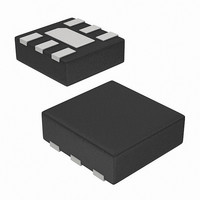ISL29012IROZ-T7 Intersil, ISL29012IROZ-T7 Datasheet - Page 9

ISL29012IROZ-T7
Manufacturer Part Number
ISL29012IROZ-T7
Description
IC SENSOR LIGHT-DGTL I2C 6-ODFN
Manufacturer
Intersil
Datasheet
1.ISL29012IROZ-EVALZ.pdf
(15 pages)
Specifications of ISL29012IROZ-T7
Wavelength
540nm
Output Type
I²C™
Package / Case
6-ODFN
Lead Free Status / RoHS Status
Lead free / RoHS Compliant
saturation (Figure 18). When using the ISL29012 in high lux
applications, one can reduce the R
Range4, the lowest gain to avoid saturation. For example,
R
100,000 lux. If you are operating the ISL29012 at a lower
range/higher gain and detect a zero output, the firmware
should change the range and recheck the ALS count. One of
two situations will be identified. If the output is non-zero, the
ISL29012 is saturated. If the output remains zero, the
ISL29012 is in a totally dark environment.
ALS Range For Various Light Sources
Figure 9 shows spectrum response of various light sources.
Fluorescent has little IR content while sunlight, halogen and
incandescent light have large IR content. Since both the
internal photo diodes D1 and D2 are sensitive to IR
spectrum, they saturate at a higher level for the fluorescent
light source in comparison to the other 3 light sources. This
effect is shown in Figure 22.
Unstable Ambient Light Condition
The ISL29012 sequentially measures the difference in the
output of two diodes. That's suitable since most changes in
ambient light are gradual and any difference between the
ambient light conditions for D1 and D2 are negligible.
However, it is possible to cause an abrupt change in
brightness with a fast-moving hand over the sensor or
passing a tree shadow in a fast moving car. To handle these
anomalies, we suggest comparing several sequential
readings and discarding any data with sudden changes.
Flat Window Lens Design
A window lens will surely limit the viewing angle of the
ISL29012. The window lens should be placed directly on top
of the device. The thickness of the lens should be kept at
minimum to minimize loss of power due to reflection and
also to minimize loss of loss due to absorption of energy in
the plastic material. A thickness of t = 1mm is recommended
for a window lens design. The bigger the diameter of the
window lens the wider the viewing angle is of the ISL29012.
Table 14 shows the recommended dimensions of the optical
window to ensure both 35° and 45° viewing angle. These
dimensions are based on a window lens thickness of 1.0mm
and a refractive index of 1.59.
EXT
= 25kΩ is recommended with ambient light near
9
EXT
value and select
ISL29012
.
Window with Light Guide Design
If a smaller window is desired while maintaining a wide
effective viewing angle of the ISL29012, a cylindrical piece of
transparent plastic is needed to trap the light and then focus
and guide the light on to the device. Hence, the name light
guide or also known as light pipe. The pipe should be placed
directly on top of the device with a distance of d1 = 0.5mm to
achieve peak performance. The light pipe should have a
minimum of 1.5mm in diameter to ensure that whole area of
the sensor will be exposed. See Figure 5.
t = 1
d1
D
d
* All dimensions are in mm.
TABLE 14. RECOMMENDED DIMENSIONS FOR A FLAT
TOTAL
D
LENS
WINDOW LENS
ISL29012
E =
TOTAL
1.5
2.0
2.5
3.0
3.5
DATA
2
15
Thickness of lens
Distance between ISL29012 and inner edge of lens
Diameter of lens
Distance constraint between the ISL29012 and lens
outer edge
x 2000
WINDOW DESIGN
FIGURE 4. FLAT WINDOW LENS
0.50
1.00
1.50
2.00
2.50
D1
VIEWING ANGLE
D
LENS
D
LENS
2.25
3.00
3.75
4.30
5.00
@ 35°
∅
∅ = VIEWING ANGLE
VIEWING ANGLE
D
LENS
December 10, 2008
D1
t
3.75
4.75
5.75
6.75
7.75
@ 45°
D
FN6476.1
TOTAL











